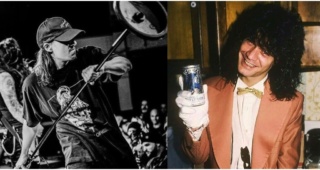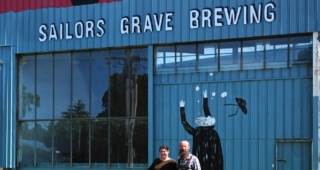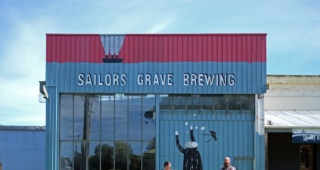Inspiration struck unexpectedly when Jack Cameron woke at six o’clock in the morning with lyrics from a Disney sea shanty sailing through his head.
Naming a brewery is no small matter, and after endless attempts to do so that were, in Cameron’s words, “all garbage,” he and his partners—his father, Michael, and his friend Jared “Red” Proudfoot—had decided to take a break. They knew the right name would come eventually, but that it might help if they stopped trying to think so goddamned hard about it.
They were right.
“I woke up and ‘yo ho ho, it’s a pirate’s life for me’ was in my head,” Jack recalls. “I called MC, said ‘Pirate Life,’ and hung up the phone. He called me back 20 minutes later and said, ‘yeah, sounds good.’ I called Red, same story, and half an hour later we had our name.”
“It might be the best accidental name for a brewery in the world,” says Michael Cameron.
His son Jack calls him “MC.”
It’s difficult to say whether these hearty Aussies grew into the brand, or if the brand embodies them. I think it’s a little of both, but when I meet the Camerons in Singapore on the second leg of their roughly five-week world tour, it’s easy to see how well the Pirate Life moniker fits them just over two years since their Adelaide brewery dropped its debut beer.
“The first beer we ever made was the 8.8% Double IPA in a 500ml can, and some people thought that was the most ludicrous thing you could ever do,” says MC. “But that’s what we wanted to do, and that’s the beer that we all loved, so that sort of told people that these guys might be a bit different.”
“A lot of people expect some pirates and some eye patches, but it’s more about the ethos and not really giving a fuck about what everybody else is doing,” says Jack. “It’s just about doing what we’re going to do, and having a good time while we do it.”
Pirate Life Sails Singapore
On a stuffy Friday afternoon in June a searing sun turns Singapore’s Central Business District into a frying pan, but it’s not the heat—or the boozing Thursday night at back-to-back events at Smith Street Taps and Freehouse—that has Pirate Life’s father-and-son duo feeling somewhat lethargic. “Mate, we had three dinners yesterday and we’ve had two lunches today, one after the other,” says 26-year-old Jack. “It’s just been like a constant food coma since we got here.”
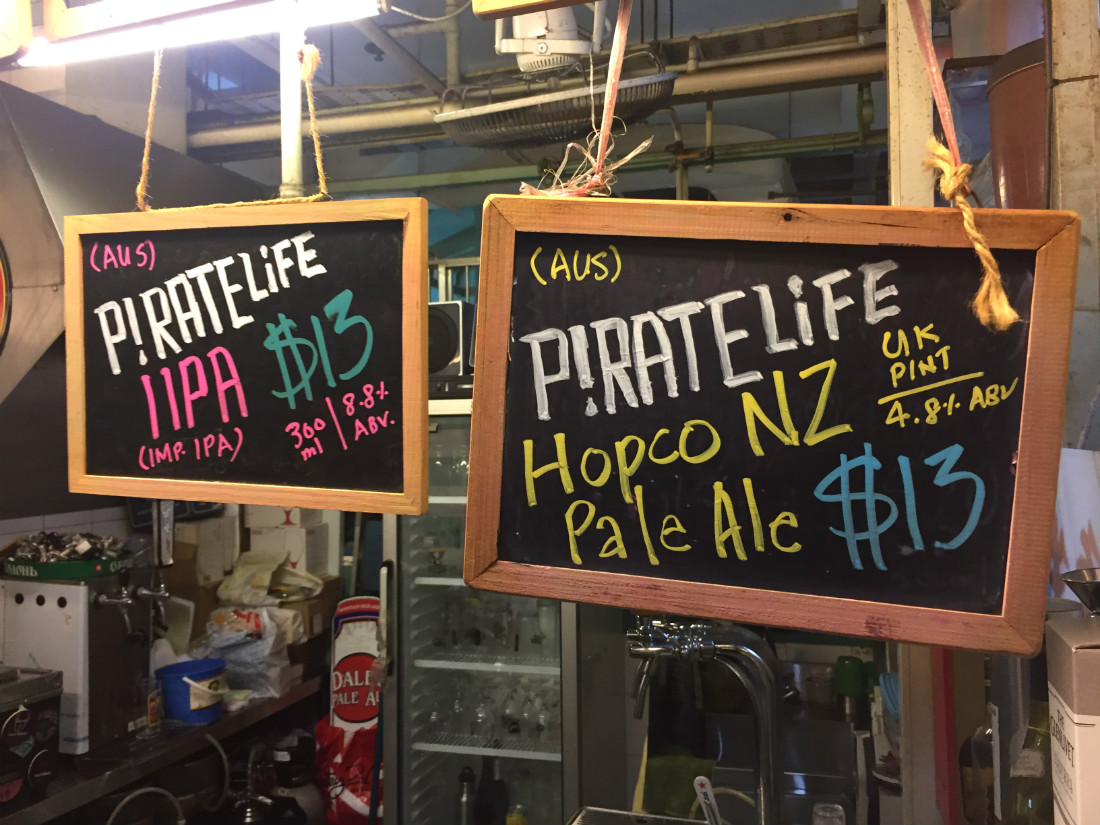
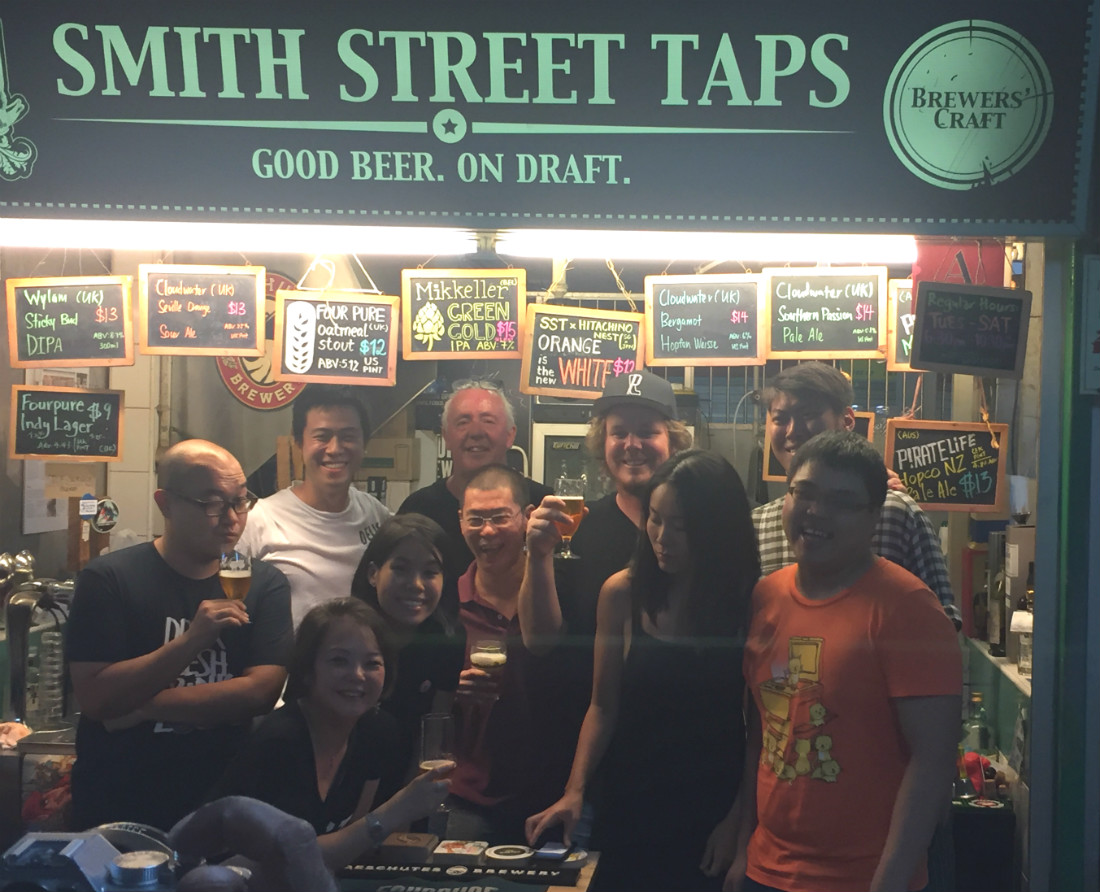
It’s more a simple statement of fact than a complaint. The Pirate Life boys are in town to help introduce the brewery to Singapore during a marathon five-day jaunt across the island that includes a seven-course beer-pairing dinner, a beer-tasting masterclass, an afternoon barbecue/can party, and guest tap events at four different beer bars. Along the way everybody ensures the guests of honor are fed well, and to eat well in Singapore means to feast, or perhaps to gorge, depending on your point of view.
At New Ubin Seafood, for instance, the chef pairs deep-fried eggplant with Pirate Life’s Pale Ale, egg masala with the Golden Ale, and smoked pork carbonara with the Double IPA. “You wouldn’t expect to have carbonara in a Chinese restaurant, but the chef was really conscious of trying to get something to work with the Double IPA, and it was just fantastic,” says MC. “You have to find the right restaurants and chefs to do these dinners, and these guys nailed it.”
It’s safe to say Pirate Life is killing it, too.
In less than three years the brewery has become one of Australia’s greatest success stories, expanding their export business while distributing to all corners of the home continent from their strategically located facility in Adelaide’s Hindmarsh suburb. Last year Pirate Life was the only brewery with more than one top-10 entry in the GABS Hottest 100 Aussie Craft Beers competition, an annual country-wide people’s choice poll that’s sort of like the Super Bowl for Australian craft breweries. They placed three beers in the top 10, in fact, with the Double IPA clocking second place (behind Stone & Wood’s ubiquitious Pacific Ale), the IPA fifth, and the Pale Ale seventh; Pirate Life’s Throwback IPA made it to number 20, as well.
A bigger brewery is already in the works, too. At the moment Pirate Life maxes out production at around 3.5 million liters a year in its current facility, which is outfitted with two 2,500-liter brew kits and 16 fermentation tanks that can collectively handle 105,000 liters. When the new brewery opens in 2018, the Camerons say they’ll cut back to around 1 million liters per year at the original location while transforming it into an incubator of sour ales, barrel-aged beers, and small experimental brews. Production of Pirate Life’s core beers will then be moved to the new place, where the brewery plans to pump out five to six million liters annually for starters, with room for more down the road.
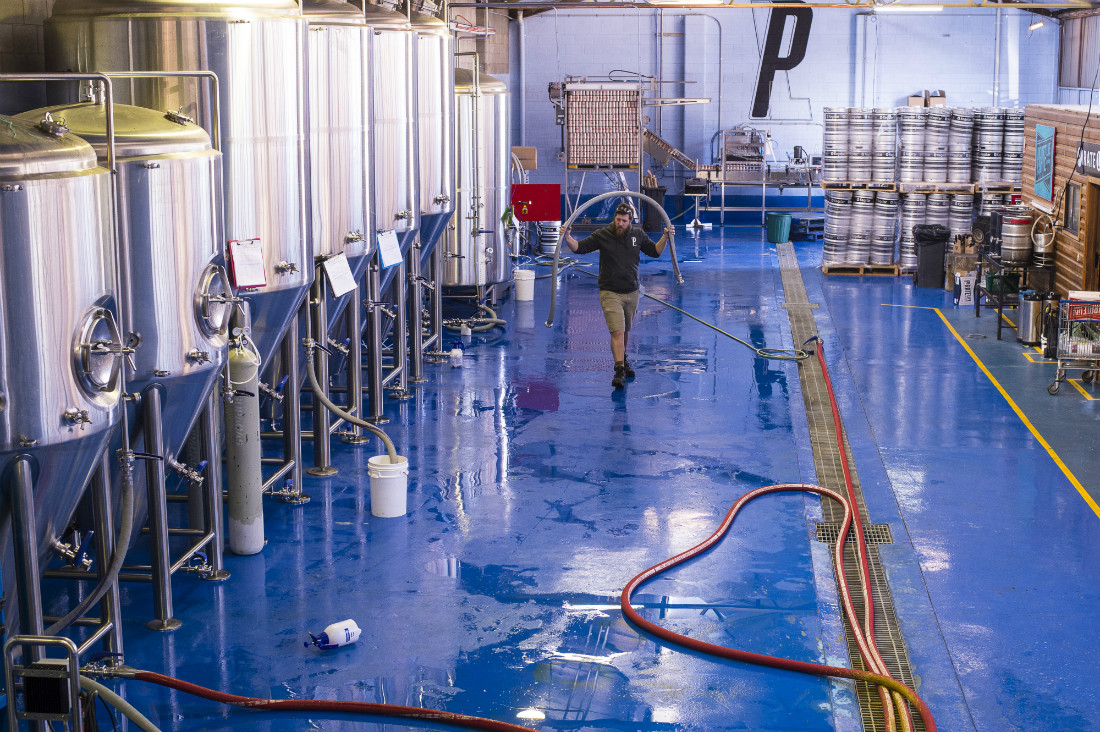


In other words, Pirate Life is doubling its capacity and getting more esoteric around the edges. It’s a big jump, and as with any bold move like this it’ll require discipline to maintain not only the momentum but, most importantly, the character and consistency of the beers upon which the brewery has staked its positive reputation.
“We really focus on quality, which underpins consistency,” says MC. “What Jack learned at Little Creatures and Red at Cheeky Monkey is that every beer that leaves the brewery has to be the same all the time. If you want to have brand loyalty and consistency, quality and control is really important.”
“There’s so much beer out there now. If you’re off once or twice, there are 3,000 pale ales available so they’ll go try another one,” says Jack. “It’s about making sure they’re going to come back every single time and it’s going to taste just as good. The big guys do it the best. Even if their beers don’t taste great, they taste the same every single time you drink it. That’s what Little Creatures does so well.”
A Pirate’s Life
We meet not over beers but rather herbal Chinese tea at Si Chuan Dou Hua, an upscale-ish Cantonese restaurant on the 60th floor of UOB Plaza. Traditional oriental string music plays in the background, and the mildly surprised looks the prim afternoon tea clientele discreetly flash upon our arrival confirms the fish-out-of-water feeling among the three of us.
To be fair, we do stand out. Jack and MC wear matching light-blue shorts and black Pirate Life T-shirts. Jack’s shaggy just-rolled-out-of-bed hair curls in tufts from the bottom of his Pirate Life baseball hat. MC has thinning white hair and looks like he could have once been a wrestler. The Camerons both have quick, conspiratorial laughs and a healthy sense of humor, qualities that probably come in handy when you’re traveling together from Adelaide to Hong Kong to Singapore to London to Oslo to Stockholm to Sydney to Newcastle before a return flight home.
“Luckily we’re father and son and know each other well enough, so if we do get sick of each other we just go to our room or go for a walk or whatever,” says MC.
“And we never sit next to each other on an airplane,” Jack chimes in. “Flights are meant to be a peaceful period of life.”
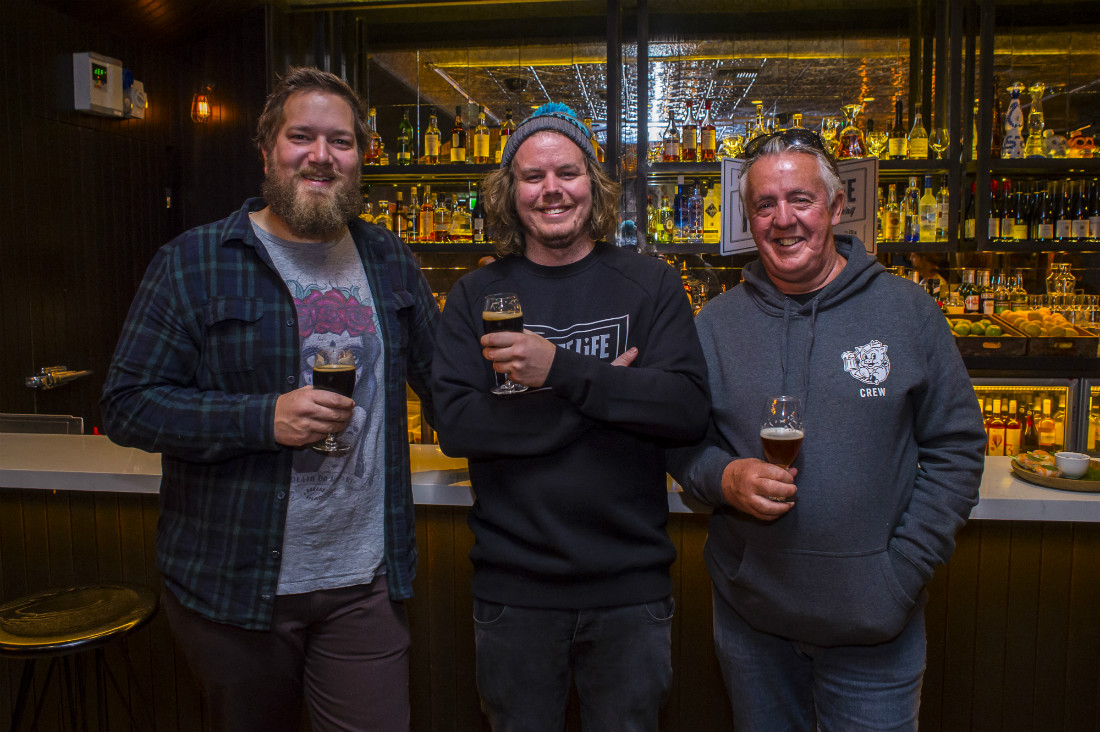
It’s quite an investment of time and money for the Camerons to visit each and every one of Pirate Life’s new export markets to personally help launch the brand. Nobody would blame them for simply packing up the kegs and cans, shipping them out, and letting the local distributors take care of it from there. It’s this hands-on approach, however, that they say helped the brewery thrive out of the gate in a city, Adelaide, that’s notoriously tough on newcomers.
“If you can grow a brand in Adelaide, you end up with this sort of strength about it. Adelaide people are very, very parochial. They love good things South Australian, so they’ll be harsh on you if you’re not good,” MC says. “One of the things we did when we were building the brewery was go around drinking three or four nights a week in different bars, wearing our T-shirts, to have a beer and talk with the barmen. We did that for four months, probably visiting 60 or 70 bars, so there was a little bit of buzz around it when we opened.”
Related: At Bush Shack Brewery, Mind the Bird Poo
After Pirate Life released its first beers in March 2015, the Camerons and Proudfoot spent the following year participating in some 250 events across the country to further spread the word. “That’s what really built our brand in Australia,” says Jack. “The bottle shop and pub owners really appreciate you spending the time with them and building a relationship with them, and the punters like meeting the real guys behind the brands, so we’re just trying to imitate that everywhere we go.”
MC agrees.
“There are thousands of beer brands globally, and everyone has a different story,” he says. “Sitting down and having a beer with the gang, like the one last night at Smith Street Taps, who get to see the people who created the beer and the brand together… I think that’s really important.”
Roots, Bloody Roots
When Jack was 14 years old the Camerons, who are originally from Tasmania and had been living in Perth, Western Australia, moved to San Diego, CA. Jack was in high school, and MC was distributing Scotland’s BrewDog in the US, a job which had him in and out of the Stone Brewing office and led him to more than 40 states at a time when craft beer was starting to spread. He met all kinds of people working in the industry, and was exposed to countless logistical and business models that helped him gain a clear picture of where beer was heading.
Jack had no plans of attending college, so when he graduated high school MC called in a favor with BrewDog and set Jack up with an apprenticeship at the brewery. Three months later BrewDog offered the 18-year-old a full-time job, and it was during Jack’s three-year tenure there that he met Red Proudfoot, a young Australian from Western Australia’s Margaret River region. MC went to Scotland, too, for about 10 months to serve as foreman on BrewDog’s flagship bar in Aberdeen. (There are now almost 50 BrewDog bars around the world.)
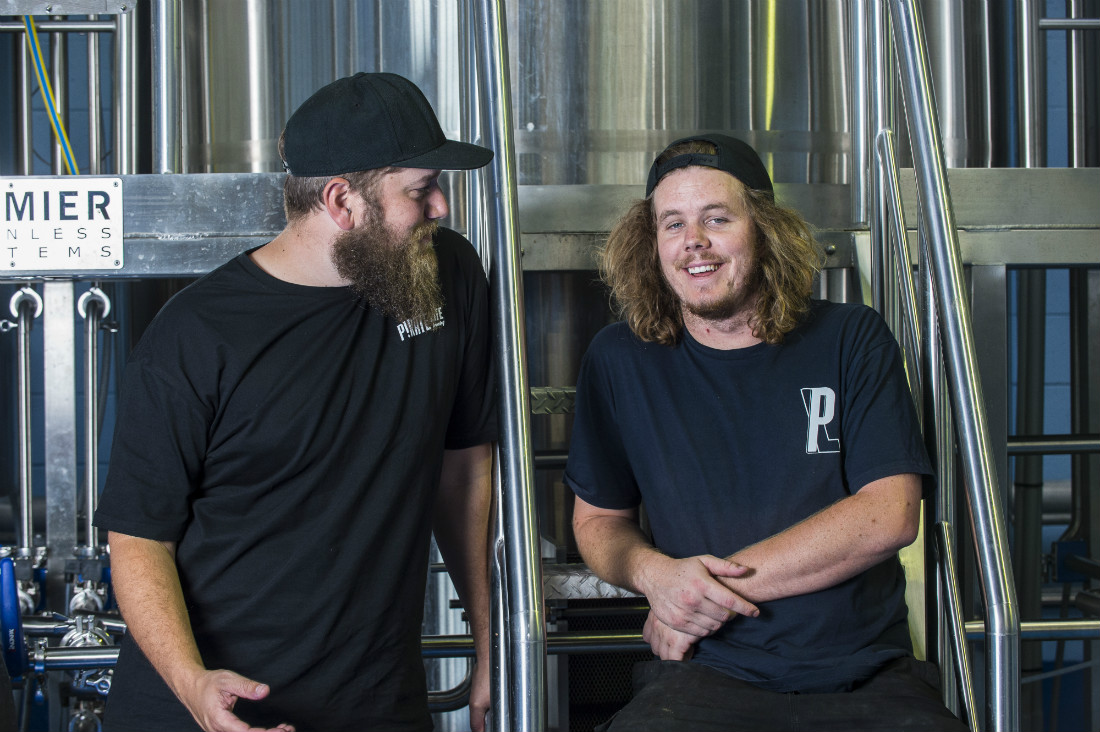
“We were cowboys back then,” says Jack. “It was very early days of BrewDog, but we were making hundreds of beers a year. You’d walk in and we’d either be brewing a Punk IPA or a bloody 14% rosemary-lavender beer or something like that, so the biggest thing I took from there was the creative side; the more technical stuff came at Little Creatures.”
While Proudfoot returned home to Margaret River to launch Cheeky Monkey Brewery & Cidery, the Camerons headed back to Perth, where Jack signed on at Little Creatures in the city’s oceanside Fremantle suburb. He did a little of everything during his three-year stint, starting in the lab before working with the brewhouse, cellar, and packaging.
“When we got back to Australia you could see how embryonic the industry was,” MC says. “We felt that if we could get the brewery up and running, brew the beers that we wanted to drink, and continue to make them consistently well, that we might have a chance.”
Beer Comes to Wine Country
Located roughly 450 miles west of Melbourne, Adelaide is the capital of Southern Australia and the country’s fifth-most populous city with around 1.3 million residents. Blessed with a Mediterranean-like climate, this is undoubtedly Wine Country. From the hundreds of well-established cellars in the Adelaide Hills, Barossa, and Clare Valley to newer vineyards in places like Southern Flinders and the Limestone Coast, the region handles much of Australia’s wine production.
“It’s a low-key Melbourne,” says Jack. “It’s got the bars, it’s got the restaurants, it’s got the footie, but not as many people and more relaxed.”
Pirate Life saw Adelaide as an ideal fit for multiple reasons. First, its central location meant faster (and cheaper) distribution around Australia than if they’d stayed in Western Australia, particularly since the bulk of their business would be on the east coast. Second, though it was already one of Australia’s premier food and wine destinations, craft beer was still a relatively nascent movement.
“We wanted to be a national brewery straight off the bat, and from Adelaide you can send beer to Melbourne and Sydney overnight, to Queensland in two days, and to Perth in three days, so it made sense to get the beer out quickly,” says Jack.
“The Adelaide beer scene was just starting to get a bit of a wave, so it was a good time to jump in and entrench ourselves and be a part of it,” MC continues. “There’s a really good food culture and a really good wine culture, so it just made sense that beer would work, as well. We love Adelaide and are proud to be there.”

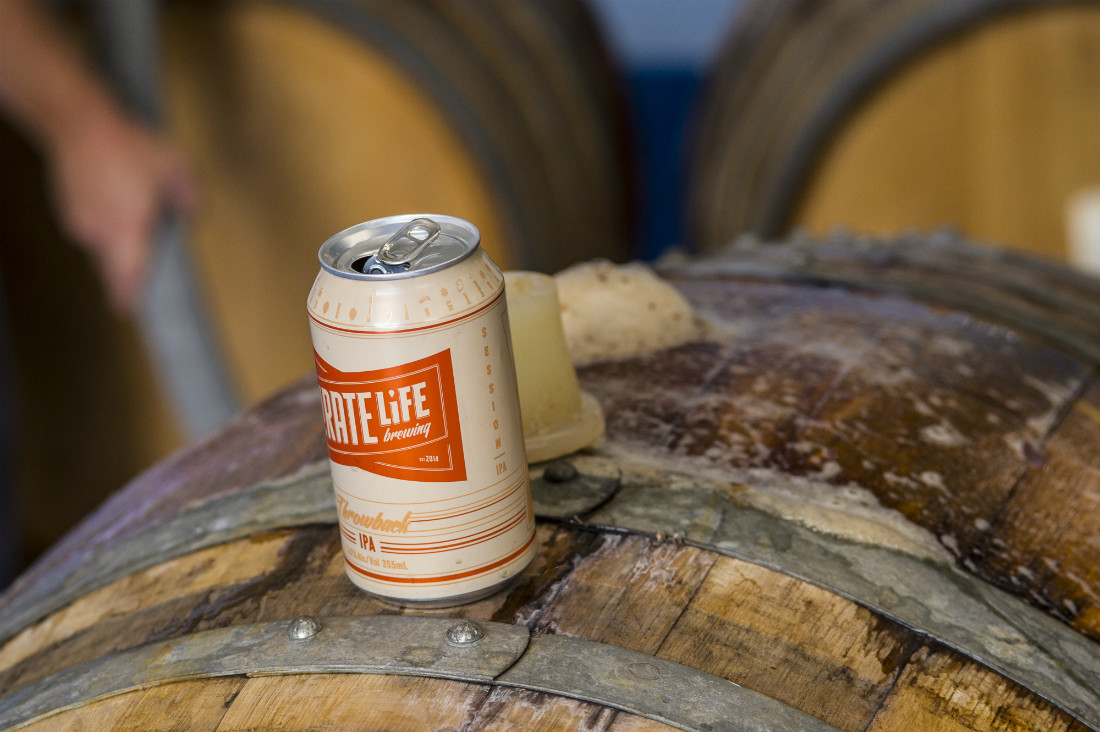
The only drawback thus far, they say, has been intermittent power outages. That can be a costly problem. For instance, Jack says the brewery once lost power for 16 hours just after mashing a batch of Throwback IPA—problem-solving time.
“We’d always planned on doing a Berliner Weisse, but just hadn’t made time for it, so instead of dumping that mash we left it in the mash tun for 3.5 days, soured it, then got it out and fermented it in the barrel for a few months with some apricots,” says Jack. “It turned out pretty well.”
[Ed. Note: Mashing is the process during brewing in which the barley and/or other grains are heated in hot water to break down their enzymes and turn the starches into fermentable sugars.]
Yes, We Can
This may change once its barrel-aging program takes flight, but Pirate Life is an exclusively canning (and kegging) brewery; the Camerons say that they’ve only bottled one beer thus far. “Canning is becoming the norm, and I think that’s become a global trend,” says MC. “If you’re making flavorsome, hop-driven, good quality beers you want to put them in a can because it’s the best thing for the beer. The beer is going to taste better, last longer, and have a more consistent flavor.”

The only way to erase the canning stigma—and it’s particularly difficult to overcome in developing craft markets like Southeast Asia—is to package consistently great beers in cans. That’s exactly what pro-canning Australian breweries like Pirate Life and Modus Operandi Brewing Co in Mona Vale, NSW, are doing, but those early adopters are just two of many, of course. As MC notes craft breweries around the world are increasingly turning to the can including, on a side note, many of my favorites in the UK, Beavertown Brewery, Cloudwater Brew Co, and Magic Rock Brewing among them.
Pirate Life’s canning evangelism is on full display at its “Comeback of the Tinny” barbecue, held on the Camerons’ last day in Singapore. The cans sell out well before the evening is over.
I don’t make it there, but the night before, a couple hours after we meet at Si Chuan Dou Hua, I bump into Jack and MC at 3rd Culture Brewing Co’s one-year anniversary party at Maxwell Food Centre. Jack polishes off a Pirate Life Double IPA and apologizes for having to leave so early.
“Mate, they’re taking us to dinner… and we just ate lunch!”
————–
Pirate Life Brewing beers are distributed across Australia–here are the venues in which you’ll find them.
High fives to Pirate Life’s Singapore distributor, The Mad Tapper, for help facilitating this interview.
All photos, except for those taken in Singapore at Smith Street Taps, courtesy of Pirate Life Brewing. None of these photos can be reprinted, reused, or otherwise shamelessly stolen.



